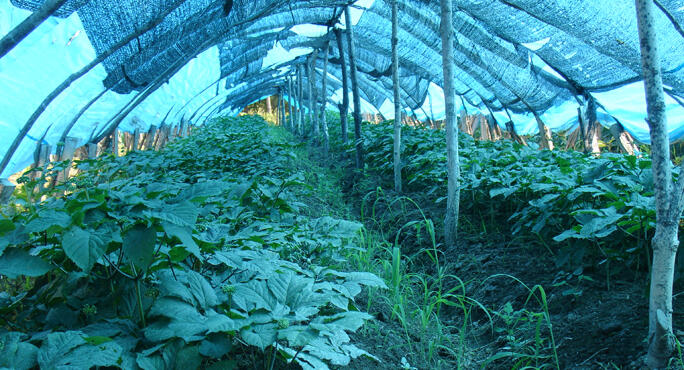
Panax Ginseng in Cultivation Tunnel. Photo by: Chris Kilham © 2010
Common Name
Botanical Name
AKA
Ginseng is a tonic herb used for rejuvenate and invigorate. It is considered an adaptogen, providing non-specific protection against various mental, physical and environmental forms of stress. Panax ginseng is a slow-maturing perennial herb native to the mountain forests of northeastern China, Korea, and Russia. The plant is cultivated extensively in China, Japan, Korea, Russia, Canada and Wisconsin in the US. Ginseng usually starts flowering at its fourth year and the roots take four to six years to reach maturity. Panax ginseng is one of the most heavily cultivated and widely consumed herbs on earth.
Ginseng root consists of the dried main root, lateral roots and root hairs or “tailings” of P. ginseng C.A. Meyer. According to Germany’s Commission E, ginseng root contains at least 1.5% ginsenosides, calculated as ginsenoside Rg1. Natural unprocessed ginseng root is white in appearance. So-called red ginseng root is prepared from white ginseng by various processing methods, such as steaming the fresh root before drying. Panax ginseng is sold in types and grades, depending on its geographic origin, root maturity, parts of the root used (main root or “tailings”), and methods of preparation or processing such as bleaching or processing into “red” root.
Ginseng's genus name Panax is derived from the Greek, and means panacea or cure-all. In Asian medicine, dried ginseng is used as a tonic to revitalize and replenish vital energy, which is referred to as qi or chi. Ginseng is traditionally used as an aid during convalescence and as a prophylactic to build resistance, reduce susceptibility to illness, and promote health and longevity. In traditional Chinese medicine Panax ginseng is usually prescribed in combination with other herbs as “teapot” medicine. 1,2,3,4
Panax ginseng is listed in the national pharmacopeias of China, Japan, Russia, Austria, France, Germany and Switzerland. It is widely used to treat fatigue, impotence, lack of appetite, headache, dizziness, cancer and rheumatism. The Pharmacopoeia of the People's Republic of China indicates its use for prostration with impending collapse marked by cold limbs and faint pulse; diminished function of the spleen with loss of appetite; diabetes caused by "internal heat"; general weakness with irritability and insomnia in chronic diseases; impotence or frigidity; and heart failure and cardiogenic shock. 2, 7
Phytochemicals and Activities
Ginseng root contains various polysaccharides, saponins, sterols, polyalkenes and essential oil. The biologically active constituents in P. ginseng are triterpene saponins known collectively as ginsenosides. They are also referred to in some literature as “panaxosides.” At least 30 ginsenosides have been identified in Panax ginseng. Of these, ginsenosides Rg1 , Rc, Rd, Rb1 , Rb2 , and Rb0 are generally regarded as the most important. Ginsenoside values of ginseng root vary according to origin, plant maturity and other factors.
Ginseng appears to act as a CNS stimulant, promotes resistance to stress and fatigue, and helps to improve memory. The root and its extracts increase mental and physical work capacity, The biological activities of individual ginsenosides appear to work in opposition to one another. Ginsenoside Rb1 acts as a CNS suppressant, while ginsenoside Rg1 acts as a CNS stimulant. Ginseng's various biological activities are varied and complex, due not only to ginsenosides but to other compounds such as panacene, which demonstrates hypoglycemic activity, at least one compound with insulinomimetic properties, and compounds which demonstrate antioxidant and antifatigue properties in animal studiess. 1,2,3,5,6,7
Ginseng is reported to possess hormone-like and cholesterol-lowering effects, promotes vasodilatation, and act as an anxiolytic and antidepressant. Numerous animal studies have found whole ginseng extracts and purified ginsenosides effective in stimulating learning, memory, and physical capabilities, promoting radioprotection, improving resistance to infection, possessing antioxidant and antifatigue effects, enhancing energy metabolism, and reducing plasma total cholesterol and triglycerides while elevating HDL levels. 6,7
References
1. Bruneton, J. 1995. Pharmacognosy, Phytochemistry, Medicinal Plants. Paris: Lavoisier Publishing.
2. Leung, A.Y. and S. Foster. 1996. Encyclopedia of Common Natural Ingredients Used in Food, Drugs and Cosmetics, 2nd ed. New York: John Wiley & Sons, Inc.
3. Wichtl M, Bisset NG (eds.). Herbal Drugs and Phytopharmaceuticals. Trans from 2nd German ed., (Stuttgart: Medpharm GmbH Scientific Publishers. 1994).
4. Bown, Deni. The Herb Society Of America Encyclopedia of Herbs & Their Uses. (1st ed., (New York: Dorling Kindersley,1995)
5. Dr. Duke’s Phytochemical and Ethnobotanical databases http://www.ars-grin.gov/cgi-bin/duke/farmacy2.pl February 2, 2006.
6. Blumenthal M, Busse W, Goldberg A, Gruenwald J, Hall T, Riggins CW, Rister RS (eds.). The Complete German Commission E Monographs: Therapeutic Guide to Herbal Medicines. S. Klein, R.S. Rister (trans.). 1st ed., (Austin, TX: American Botanical Council. 1998).
7. Blumenthal M, Goldberg A, Brinckmann J (eds). Herbal Medicine: Expanded Commission E Monographs. 1st ed., (Newton, MA: Integrative Medicine Communications. 2000).

